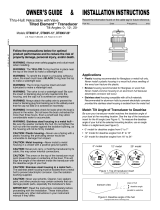
4
Copyright © 2006 - 2011 Airmar Technology Corp. All rights reserved.
2. Using the appropriate size outside hull hole saw, cut a hole from outside
the hull through the outer skin only (see table on page 1) (see Figure 4).
3. From inside the hull using the appropriate size hull interior hole saw, cut
through the inner skin and most of the core (see table on page 1). The core
material can be very soft. Apply only light pressure to the hole saw after
cutting through the inner skin to avoid accidentally cutting the outer skin.
4. Remove the plug of core material, so the inside of the outer skin and the
inner core of the hull is fully exposed. Sand and clean the inner skin,
core, and the outer skin around the hole.
5. If you are skilled with fiberglass, saturate a layer of fiberglass cloth with
a suitable resin and lay it inside the hole to seal and strengthen the
core. Add layers until the hole is the correct diameter.
Alternatively, a hollow or solid cylinder of the correct diameter can be
coated with wax and taped in place. Fill the gap between the cylinder and
hull with casting epoxy. After the epoxy has set, remove the cylinder.
6. Sand and clean the area around the hole, inside and outside, to ensure
that the marine sealant will adhere properly to the hull. If there is any
petroleum residue inside the hull, remove it with either mild household
detergent or a weak solvent (alcohol) before sanding.
7. Proceed with “Bedding” and “Installing” on page 2.
Maintenance, Parts & Replacement
Anti-fouling Paint
Surfaces exposed to salt water must be coated with anti-fouling
paint. Use water-based anti-fouling paint only. Never use ketone
based anti-fouling paint, since ketones can attack many plastics
possibly damaging the transducer. Apply anti-fouling paint every 6
months or at the beginning of each boating season.
Retractable models—Paint the following surfaces:
• Outside wall of the insert below lower O-ring and exposed end
• Bore of the housing up 30mm (1-1/4”)
• Exterior flange of the housing
• Blanking plug below the lower O-ring including the exposed end
Cleaning
Aquatic growth can accumulate rapidly on the transducer’s
surface, reducing its performance within weeks. Clean the surface
with a Scotch-Brite® scour pad and mild household detergent,
being careful to avoid making scratches. If the fouling is severe,
lightly wet sand it with fine grade wet/dry paper.
Retractable Models: Blanking Plug
1. The O-rings must be intact and well lubricated to make a
watertight seal. On the blanking plug, inspect the O-rings
(replace if necessary) and lubricate them with the silicone
lubricant supplied or petroleum jelly (Vaseline®).
2. Remove the transducer insert from the housing by removing the
safety wire and unscrewing the cap nut (see Figure 2).
3. With the blanking plug ready in one hand, pull the transducer
insert most of the way out. Remove the insert and rapidly
replace it with the blanking plug. Seat it into place with a
pushing twisting motion until the key fits into the notch in the
housing. With practice, only 250ml (10oz.) of water will enter the
boat. Screw the cap nut in place and hand tighten only. Do not
over tighten.
D/DT800—Being sure the blanking plug is fully inserted into the
housing, screw the cap nut several turns until the threads are
engaged. Continue to tighten the cap nut completely for a
watertight seal. Hand tighten only. Do not over tighten.
4. Reattach the safety wire to prevent the blanking plug from
backing out in the unlikely event that the cap nut fails or is
screwed on incorrectly.
Retractable Models: O-rings
O-rings must be free of abrasions and cuts to ensure a watertight
seal. On the insert and blanking plug, inspect the O-rings (replace
if necessary) and lubricate them with the silicone lubricant
supplied or petroleum jelly (Vaseline®).
Retractable Models: Winterizing
After the boat has been hauled for winter storage, remove the
blanking plug to let the water drain away before reinserting it. This
will prevent any water from freezing around the blanking plug and
possibly cracking it.
Replacement Transducer & Parts
The information needed to order a replacement Airmar transducer
is printed on the cable tag. Do not remove this tag. When
ordering, specify the part number, date, and frequency in kHz. For
convenient reference, record this information on the top of page one.
Lost, broken, or worn parts should be replaced immediately.
D/DT800 O-rings 33-519-01
Obtain parts from your instrument manufacturer or marine dealer.
Gemeco Tel: 803-693-0777
(USA) Fax: 803-693-0477
Airmar EMEA Tel: +33.(0)2.23.52.06.48
(Europe, Middle East, Africa) Fax: +33.(0)2.23.52.06.49
Model
Housing Kit, Washer,
Spacer, or Isolation Bushing
Hull Nut Cap Nut
Blanking
Plug
B17
B21
33-100 (bronze, low profile)
33-224-01 (bronze, flush)
02-030
04-234-1 (plastic)
02-131-01 (bronze)
33-414
B22
B117
04-646-01 (spacer) 02-030 — —
P5 04-002
P17 33-417 (plastic, low profile) 04-004 04-234-1 (plastic) 33-414
P19
P219
P269
—04-004——
P217
P314
33-217 (plastic, flush)
33-092-01 (plastic, flush)
04-004 04-234-1 (plastic) 33-414
P319 04-646-01 (spacer) 04-004 — —
SS577
33-495-01 (stainless steel,
low profile)
04-186-1 (bushing)
20-570-01 04-234-1 (plastic) 33-414
Figure 4. Preparing a cored fiberglass hull
inner skin
core
outer skinsolid or hollow cylinder
pour in
casting
epoxy
9-12 mm
(3/8-1/2")
larger than the
hole through the
hull’s outer skin
hull thickness
Copyright © 2005 Airmar Technology Corp.
AIRMAR
®
TECHNOLOGY CORPORATION
35 Meadowbrook Drive, Milford, New Hampshire 03055-4613, USA
www.airmar.com





